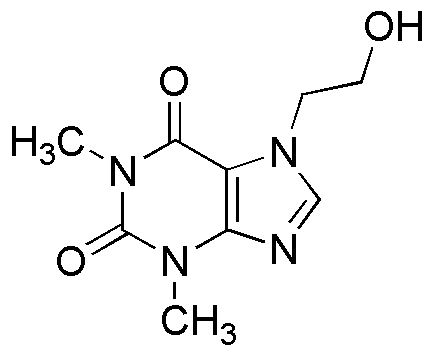7-(b-Hydroxyethyl)theophylline is widely utilized in research focused on
- Pharmaceutical Development: This compound is often used in the formulation of medications aimed at treating respiratory conditions like asthma and chronic obstructive pulmonary disease (COPD), enhancing the efficacy of bronchodilators.
- Research on Caffeine Metabolism: It serves as a valuable tool in studies investigating the metabolism of caffeine and related compounds, helping researchers understand their pharmacokinetics and effects on human health.
- Drug Delivery Systems: The compound is explored in the development of advanced drug delivery systems, where its unique properties can improve the solubility and bioavailability of therapeutic agents.
- Cardiovascular Research: It is used in studies related to cardiovascular health, particularly in understanding how it influences heart rate and blood pressure, providing insights for new treatments.
- Analytical Chemistry: 7-(b-Hydroxyethyl)theophylline is employed in analytical methods to quantify the presence of related substances in biological samples, aiding in the development of quality control measures in pharmaceuticals.
General Information
Properties
Safety and Regulations
Applications
7-(b-Hydroxyethyl)theophylline is widely utilized in research focused on
- Pharmaceutical Development: This compound is often used in the formulation of medications aimed at treating respiratory conditions like asthma and chronic obstructive pulmonary disease (COPD), enhancing the efficacy of bronchodilators.
- Research on Caffeine Metabolism: It serves as a valuable tool in studies investigating the metabolism of caffeine and related compounds, helping researchers understand their pharmacokinetics and effects on human health.
- Drug Delivery Systems: The compound is explored in the development of advanced drug delivery systems, where its unique properties can improve the solubility and bioavailability of therapeutic agents.
- Cardiovascular Research: It is used in studies related to cardiovascular health, particularly in understanding how it influences heart rate and blood pressure, providing insights for new treatments.
- Analytical Chemistry: 7-(b-Hydroxyethyl)theophylline is employed in analytical methods to quantify the presence of related substances in biological samples, aiding in the development of quality control measures in pharmaceuticals.
Documents
Safety Data Sheets (SDS)
The SDS provides comprehensive safety information on handling, storage, and disposal of the product.
Product Specification (PS)
The PS provides a comprehensive breakdown of the product’s properties, including chemical composition, physical state, purity, and storage requirements. It also details acceptable quality ranges and the product's intended applications.
Certificates of Analysis (COA)
Search for Certificates of Analysis (COA) by entering the products Lot Number. Lot and Batch Numbers can be found on a product’s label following the words ‘Lot’ or ‘Batch’.
*Catalog Number
*Lot Number
Certificates Of Origin (COO)
This COO confirms the country where the product was manufactured, and also details the materials and components used in it and whether it is derived from natural, synthetic, or other specific sources. This certificate may be required for customs, trade, and regulatory compliance.
*Catalog Number
*Lot Number
Safety Data Sheets (SDS)
The SDS provides comprehensive safety information on handling, storage, and disposal of the product.
DownloadProduct Specification (PS)
The PS provides a comprehensive breakdown of the product’s properties, including chemical composition, physical state, purity, and storage requirements. It also details acceptable quality ranges and the product's intended applications.
DownloadCertificates of Analysis (COA)
Search for Certificates of Analysis (COA) by entering the products Lot Number. Lot and Batch Numbers can be found on a product’s label following the words ‘Lot’ or ‘Batch’.
*Catalog Number
*Lot Number
Certificates Of Origin (COO)
This COO confirms the country where the product was manufactured, and also details the materials and components used in it and whether it is derived from natural, synthetic, or other specific sources. This certificate may be required for customs, trade, and regulatory compliance.


